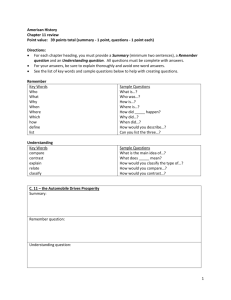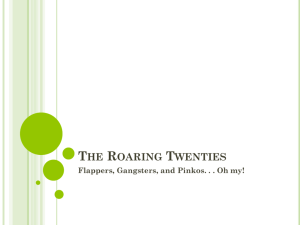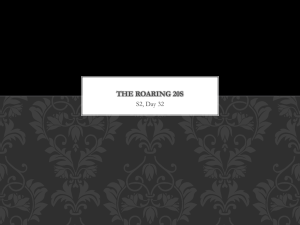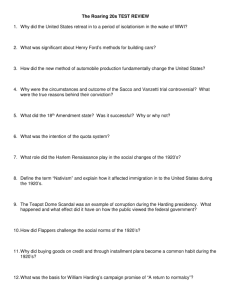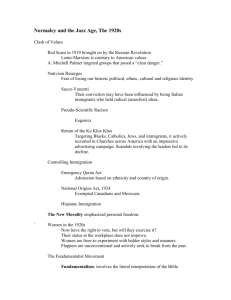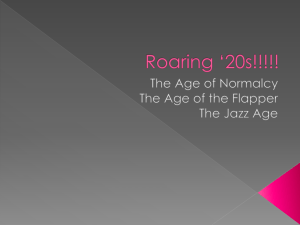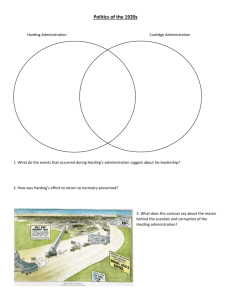The 1920s
advertisement
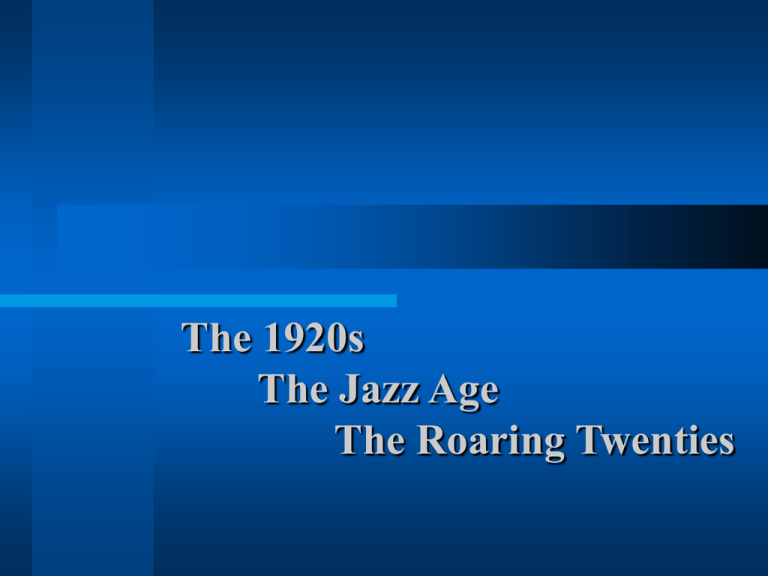
The 1920s The Jazz Age The Roaring Twenties A Decade of Contrasts Isolationism vs. Social Unrest Return to Normalcy vs. Political Turmoil Prohibition vs. Speakeasies Traditionalism vs. Modernism Economic Boom vs. Financial Bust Isolationism vs. Social Unrest November 11, 1918 – Armistice Day: Cease-Fire in Europe June 28, 1919 – Treaty of Versailles Signed November 1919 – U.S. Senate Rejected Treaty • Fear of alliances, being drawn into future wars • U.S. preferred a policy of isolationism • U.S. did NOT join The League of Nations A Gap in the Bridge . . . Isolationism vs. Social Unrest 1919 – Racial Tension – Returning African-Americans soldiers wanted immediate equality – Great Migration witnessed half a million Black Americans move to the North • Settled in areas previously dominated by Whites • Return of White soldiers led to competition – Summer of 1919 • Over 20 race riots throughout country • Chicago Race Riot – 38 Dead, over 500 injured Isolationism vs. Social Unrest 1919 – A Year of Strikes • A General Strike in Seattle began a sweep of strikes across the Nation • Workers fought to keep gains achieved during WWI and for higher wages • Steelworkers strike – many are immigrants; Company blamed strike on foreign radicals Isolationism vs. Social Unrest 1919 – Red Scare Began • Fear that Communists might seize power – Attorney General A. Mitchell Palmer led series of “Palmer Raids” • Raided headquarters of “radicals” • Deported thousands without actual evidence – Effect of Red Scare • Americans link immigrants with radicalism • Congress passed laws limiting immigration Cleaning the Nest . . . More Social Unrest: Nativism Nativism Resurfaced New Immigration Laws – 1921 Emergency Quota Act • Limited Immigration to 3% of total number of ethnic group already in U.S. – 1924 National Origins Act • Made Immigration Restrictions permanent; Tightened Quota System to 2% The Case of Sacco & Vanzetti – 1920 Anarchist immigrants arrested for murder – 1927 Executed despite lack of evidence, obvious prejudice of the judge Close the Gate . . . More Social Unrest: Nativism Ku Klux Klan – 1915 New Version Founded – Central Message: White Protestant hegemony threatened by Catholics, Jews, Black Americans, Immigrants – 1924 Membership reached 4 million • Elected to State/Local Governments across U.S. Eugenics – Claimed human qualities inherited; fueled nativists’ claims of superiority of “original” American born Protestants – Warned against “mixing breeds” – W. Wilson, H. Cabot Lodge embraced ideology Normalcy vs. Political Turmoil Republicans control White House during decade 1920 Warren G. Harding elected President – Promised “a return to normalcy” after war years – Appointed “Ohio Gang”, his friends, to his Cabinet Harding on his appointments: “They’re the ones that keep me walking the floors at night” The Teapot Dome Oil Scandal – Albert Fall of the Ohio Gang leased Navy oil reserves to private interests for bribes – Some lands located in Teapot Dome, Wyoming – Fall 1st Cabinet officer to go to prison Harding’s Legacy . . . Normalcy vs. Political Turmoil 1923 Harding died on tour of the West Calvin Coolidge became president “Silent Cal” on business: – “The business of America is business” – Preferred limited to no government involvement – A move toward laissez-faire economics 1928 Republican Herbert Hoover Elected Pres. – The New Era: Harding, Coolidge, Hoover Prohibition vs. Speakeasies 18th Amendment (The Noble Experiment) Volstead Act – Provided for Enforcement of Amendment – Not enough funds or Agents Led to an increase in organized crime – Bootleggers smuggled alcohol in from Canada, Caribbean – Speakeasies emerged: secret bars, sold alcohol illegally – Judges, police bribed – Led to decrease in respect for law & order 21st Amendment – 1933 Repealed Prohibition Traditionalism vs. Modernism Fundamentalism – Religious movement (Traditionalism) – Believed in literal interpretation of the Bible – Fought against: modern consumer culture, relaxed ethics, growing urbanism 1925 Scopes Trial – – – – – – Debate over teaching of evolution in schools (Modern) John Scopes challenged TN law, fired Scopes defended by Clarence Darrow William Jennings Bryan was prosecutor Highlight of Trial: Scopes cross-examined Bryan Scopes found guilty, fined $100 The Media’s Take on the Scopes Trial More Modernism The Changing Role of Women – Empowered by work during WWI 1920: 19th Amendment The Flapper – Embraced a “New Morality” – Some women remained single, held jobs – Cut hair short (bobbed) – Hem lines rose, wore flesh-colored stockings – Smoked, drank, danced The Harlem Renaissance What was it? – Celebration of African-American achievements in the arts, literature, and music Key Feature – Rise of Jazz – Popularity of Jazz attributed to AfricanAmerican musicians – The Cotton Club a popular hangout • Black Performers, White Audience More on The Harlem Renaissance Musicians – Duke Ellington – Louis Armstrong – Bessie Smith (blues) • 1927 Highest Paid Black Artist in the World Significant Writers – Claude McKay • Worked Expressed Proud Defiance of Racism – Langston Hughes • Poet, leading voice of the African-American experience in the United States Selected Poems of Langston Hughes “I, Too” “Youth” We have tomorrow Bright before us Like a flame Yesterday, a night-gone thing A sun-down name And dawn today Broad arch above the road we came We march! I, too sing America I am the darker brother They send me to eat in the kitchen When company comes, But I laugh, And eat well, And grow strong. Tomorrow, I’ll be at the table When company comes. Nobody’ll dare Say to me, “Eat in the kitchen,” Then. Besides, They’ll see how beautiful I am And be ashamed – I, too am America African-American Politics Marcus Garvey – Jamaican immigrant – Founded the Universal Negro Improvement Association (UNIA) – Promoted “Negro Nationalism” • Opposed integration, emphasized Black nationalism and Black Pride – Opened the Black Star Line – Started a “Back to Africa” movement – Convicted of mail fraud, jailed, then deported Modernism: Pop Culture The Biggest Hero of the Decade – Charles Lindbergh “Lucky Lindy” – 1927 1st Person to Fly Solo Across the Atlantic – Symbol of American ingenuity and courage The Lost Generation – Novelists disenchanted with life following WWI – F. Scott Fitzgerald • The Great Gatsby, This Side of Paradise – Ernest Hemingway • A Farewell to Arms, For Whom the Bell Tolls – Sinclair Lewis • Main Street Modernism: Pop Culture Entertainment – Talkies • 1927 The Jazz Singer: 1st Movie with Sound • 1928 Steamboat Willie: 1st Animated Movie w/ Sound – 1920 First Commercial Radio Station • Helped create a common national culture Sports Heroes – 1927 Babe Ruth: Hits 60 Home Runs – Jack Dempsey: Heavyweight Champ Economic Boom vs. Financial Bust Republican Economic Policy: – Pro-business, relaxed regulation – Cut income taxes on highest income bracket 1922 Fordney-McCumber Tariff – Highest American tariff ever to that point – Protect American businesses Economic Boom vs. Financial Bust Time of “Prosperity” – Rising Standard of Living – Per Capita Earnings rose 22% – New electrical conveniences: refrigerators, vacuums, toasters – Heavy investment in stock market: hoped for quick profits to repay loans – Businesses spending large amounts on expansion – Buying goods on credit (installment plan) Productivity increased – Mass production created more supply, cut consumer costs Economic Boom vs. Financial Bust Henry Ford & The Automobile – Ford the 1st to use the moving assembly line – Introduced installment plan Impact of the Automobile – New Roads Built: Route 66 – Led to urban sprawl: Live farther from work – Families could vacation farther from home – Liberated isolated rural families – Led to new businesses: Service Stations, Hotels
